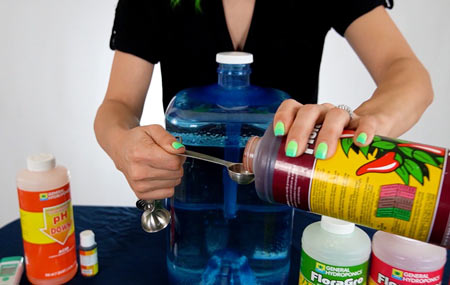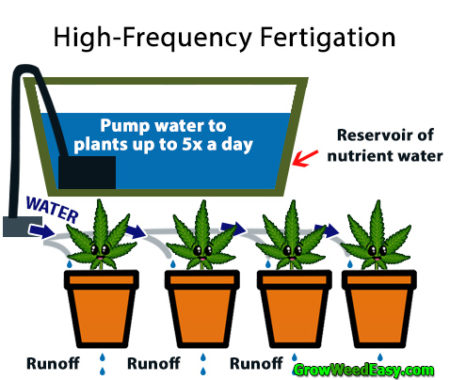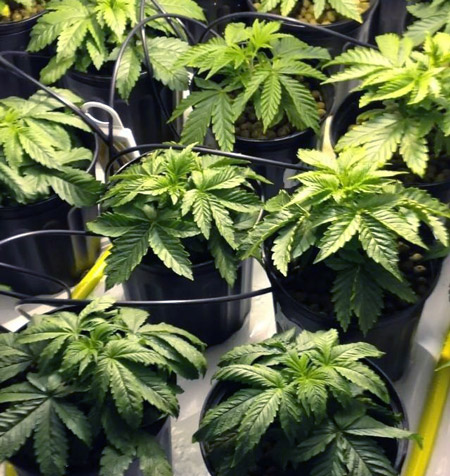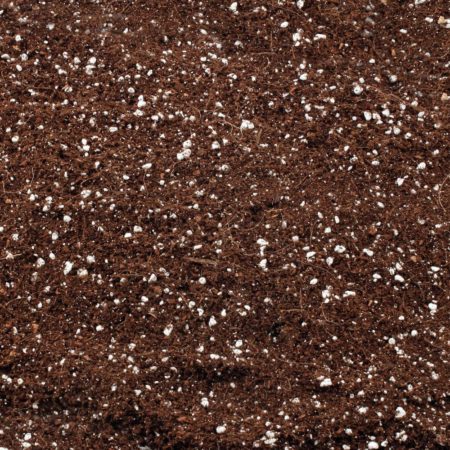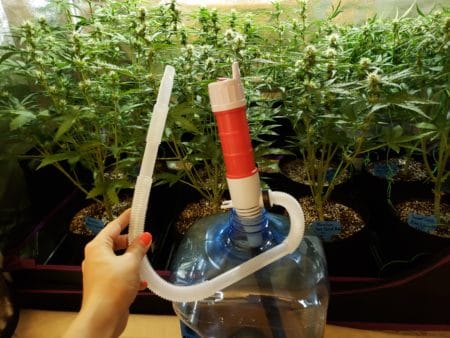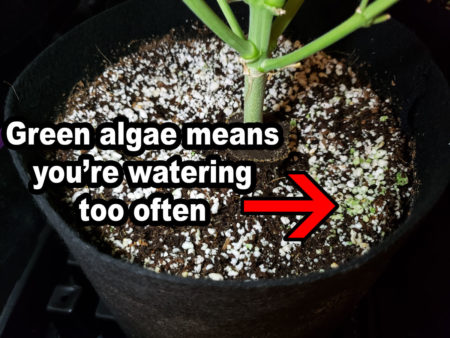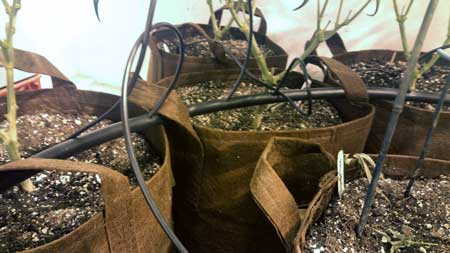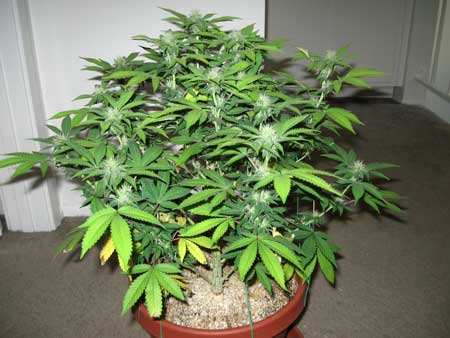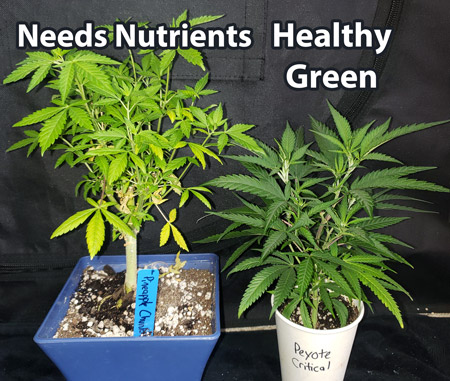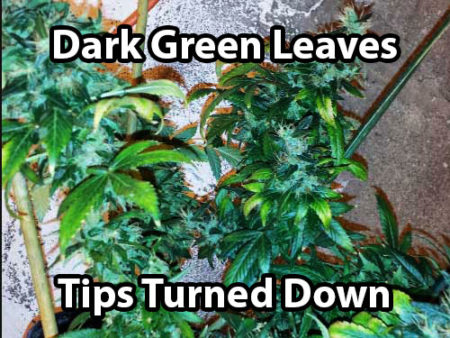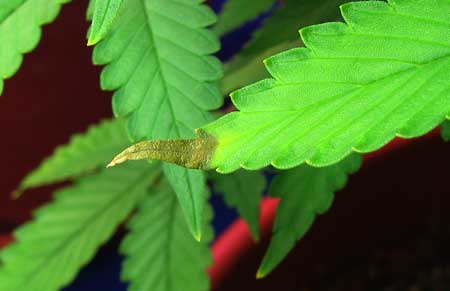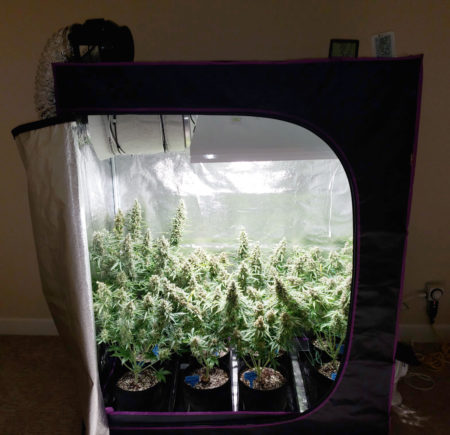by Nebula Haze
I recently received this message, “What is fertigation, and is it good for cannabis plants? Do you need to fertigate coco coir?” I decided to share the answer with everyone, as marijuana fertigation is a popular topic.
What is nutrient fertigation for cannabis plants?
Fertigation means providing nutrients in the water you give to your cannabis plants (irrigating plants with fertilizer). Weed plants typically grow faster when they get nutrients from the water as opposed to having to seek out nutrients in soil.
Fertigation just means giving nutrients in the water (“fertigation” stands for irrigating plants with fertilizer)
What is high-frequency fertigation?
A popular new cannabis growing technique is “high-frequency fertigation”. High-frequency fertigation is exactly what it sounds like: giving nutrient water to cannabis plants on a frequent basis. For example, watering plants multiple times a day with nutrient water, often with drip-irrigation (automatic watering).
This is typically done with plants grown in coco coir (ground coconut husks) plus perlite (little white rocks that create air spaces). The coco/perlite combo has air and water-holding properties that help prevent cannabis plants from getting overloaded or over-watered.
High-frequency fertigation means frequently giving nutrient water to your plants (up to 5 times a day). When done properly, plants grow faster.
What is the advantage of high-frequency fertigation?
Plants tend to grow faster when they’re getting a constant supply of nutrients, water, and oxygen.
Why don’t plants get overwatered?
“Overwatering” is the result of lack of oxygen at the plant’s roots. When roots are starved of oxygen, plants get droopy, grow slowly, and often show nutrient deficiencies.
However, with the high-frequency fertigation technique, plants are grown in a special grow medium (coco coir mixed with lots of airy perlite) which gives roots plenty of oxygen even when the grow medium is soaked. As a result, plants grow extremely fast at rates comparable to growing cannabis in hydroponics.
With high-frequency fertigation cannabis growers usually use tubing to deliver water directly to cannabis plant roots on a schedule (typically by putting the water pumps on a timer)
What is coco coir?
Coco coir is made of ground-up coconut husks. It’s a totally inert grow medium that contains no nutrients of its own and has a texture that is somewhat similar to soil. Although it used to be considered a waste product, it was discovered that plant roots grow surprisingly well in potting mixes made primarily of coco.
Coco coir is brown with stringy bits (it’s made of ground-up coconut husk after all) and is commonly mixed with light airy rocks known as perlite to add extra air pockets for oxygen-loving roots. This type of potting mix is an excellent medium for growing cannabis plants.
Some soils contain coco as an ingredient, typically as a replacement for peat moss. I personally love soil mixes that contain coco, like Coco Loco. However, when growers talking about growing cannabis plants in coco, they’re talking about growing a coco-based medium that contains no soil, and therefore is completely devoid of nutrients. With coco, you need to add all the nutrients yourself. The advantage is that coco-grown plants typically grow faster than plants grown in soil, though certain super soil mixes (like Nature’s Living Soil combined with Coco Loco) produce growth that’s just as fast in some tests. One thing to remember when it comes to growing cannabis is that there is no “best” grow medium. It’s all about figuring out what you like for yourself.
Is high-frequency fertigation the best choice for coco?
The answer is simple. There is no “best “choice for growing cannabis in coco coir. Coco coir is a flexible cannabis grow medium that can produce great weed in a wide variety of conditions. Plants grow green and healthy with a standard watering schedule similar to soil, and coco can also be a great choice for high-frequency fertigation when set up properly. Every watering method has pluses and minuses.
Success with high-frequency fertigation depends on…
- At least 50/50 coco to perlite ratio – Grow medium needs proper ratio of coco to perlite (50/50 works great). Coco holds onto water while perlite loosens it up and adds air pockets. Make sure you have plenty of perlite in your coco before starting a high-frequency fertigation schedule.
- Avoid hand-watering – Get an automatic watering system to pump water to your plants on a timer (hand-watering multiple times daily is time-consuming and prone to errors)
- Smaller pots for more frequent fertigation – Plants in big pots get overwatered if the coco doesn’t dry out between waterings. With smaller fabric pots, the plant roots get access to much more oxygen
Some growers water their cannabis by hand, but it’s unlikely any grower can keep as good a schedule as a timer.
Other tips
- Wait for seedlings to grow – don’t start until plants have a few sets of leaves (seedlings are easily overwatered)
- Give nutrients every watering – High-frequency fertigation doesn’t work well when alternating with giving plain water. You want to maintain relatively constant nutrient levels
- Give root plenty of water and oxygen – Plant roots need high levels of oxygen to get the best growth. When you notice plants are getting droopy, it’s usually a sign the roots need more oxygen. That means you either want to give less water at a time, or water less often, until plants are drinking more.
- Maintain 5.5-6.5 pH – Just like any other cannabis grow medium, one of the best ways to prevent nutrient deficiencies is to maintain pH at the roots. I prefer 6-6.5 pH in this setup as that can help prevent calcium deficiencies.
- Don’t let plants sit in water – Plants should get at least a little runoff water out of the bottom every time they’re watered to prevent nutrient buildup. Make sure to remove the runoff immediately so roots don’t sit in a pool of water
- Watch out for fungus gnats – it means you are overwatering if you see little bugs buzzing around the coco
If you notice green algae growing on top of your coco coir, that means the top is staying too wet for too long and you should either give less water at a time or water less often
Avoid high-frequency fertigation if…
- You’re a beginner who’s worried about making mistakes (high-frequency fertigation makes growing more complicated)
- Water damage in the home would be a major issue (adding pumps and drip feeds increases the chances of a water spill or other event)
- You’re trying to save money on nutrients (you go through a LOT of nutrients with high-frequency fertigation)
What About Nutrient Strength? (Including EC / PPM)
It can be tough to determine the exact amount of nutrients to give in the water because the airiness of the grow medium and frequency/amount of watering will make nutrients more or less available to plant roots. It’s recommended to start at 1/2 the recommended dose on the official nutrient schedule, and adjust from there according to the suggestions below.
Generally, the less often you water your plants, the higher levels of nutrients you need, up to a point. Adding a lot of perlite also increases the level of nutrients needed since the perlite does not hold onto much water or nutrients compared to coco. Plants are able to tolerate higher levels of nutrients once they get bigger and start growing fast.
This plant needs higher level nutrients (notice the yellowing towards the bottom and lime green color all over). If plants appear pale like this, increase the amount of nutrients overall.
For reference, this example shows the leaf color of a nutrient-hungry vs healthy plant
If you see dark leaves all over, it is a sign of a nitrogen overload and often means you’re giving too high levels of nutrients overall. If you see these symptoms, lower the amount of nutrients slightly until plants looks kelly green.
Nutrient burn is another sign of too much nutrients at once. If you see this, reduce the nutrient strength slightly until it stops spreading.
How do you measure and keep track of nutrient strength over time?
EC (electrical conductivity) and PPM (parts per million) are different ways to measure how much “stuff” there is in the water, including nutrients. EC is considered more accurate because different meters measure PPM differently. TDS (Total Disolved Solids) meters measure EC and/or PPM. When comparing your results against other growers, it’s best to go by EC to ensure you’re comparing apples to apples. Different meters might measure the same water source as 500 PPM, 640 PPM, or 700 PPM depending on how it calculates PPM.
However, either measurement works as long as you compare your results against your own numbers. Although EC seems better on paper since it’s more comparable and accurate, PPM is still around because it can be more intuitive. It’s easier to remember 650 PPM than 1.3 ms/cm (the unit for EC).
What to Do: When watering plants, measure the EC/PPM of the water going in, and compare to the measurements for the runoff water. If the EC/PPM rises significantly, that’s a sign there is nutrient buildup at the roots. If the measurement is similar for the water going in and out, it means the coco is not building up extra nutrients. If the EC/PPM coming out is lower than what you put in, you may need to raise your nutrient levels overall.
Use the EC/PPM suggestions as a general guideline at best. Most importantly, don’t forget to look at the plants. In the end, their color and health are far more important than any number. If they look like they need more or less nutrients according to the pictures above, follow what the plants are saying.

